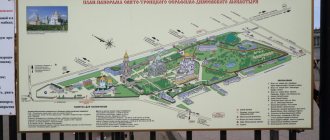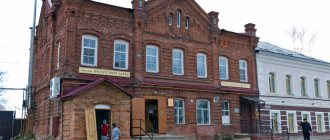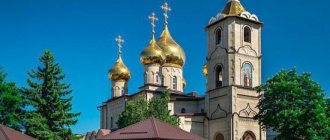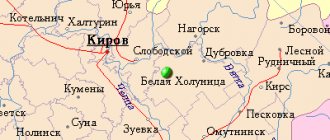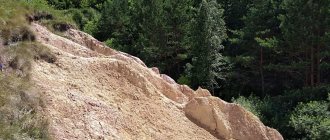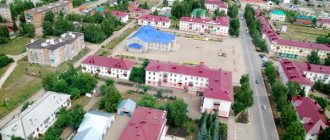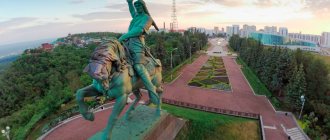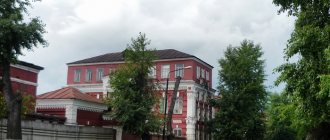Diveevo: areas, recreation, excursions, museums and churches, cuisine and restaurants, shopping and shops, attractions of Diveevo.
- Last minute tours
to Russia
In the Nizhny Novgorod region, on the banks of the Vichkinza River, stands Diveevo. The ancient village arose in 1559 and was named in honor of the founder, Prince Divey. Located at the intersection of several pilgrimage roads, it and the wooden church of St. Nicholas the Wonderworker built here often provided shelter and rest for pilgrim travelers.
In 1767, one of the pilgrims, Agafya Semenovna Melgunova, began to build a stone church in the village in honor of the Kazan Icon of the Mother of God. In 1772 it was consecrated, and Agafya decided to form a religious community here. In 1788, she received a gift of land on which the cells were built. Over the course of 1.5 centuries since the construction of the church, the monastery was built, and now it is believed that this is one of the four places on earth that the Mother of God took under her protection - it is here that she comes every day. So pilgrims and pilgrims strive to visit the Diveyevo Monastery at least once in their lives and be sure to stay there for at least one night in order to receive the blessing of the Mother of God herself. The entire history of the temple is closely connected with the name of St. Seraphim of Sarov.
A little history
15 km from Diveevo, where Sarov is now located, there was once the famous Sarov Hermitage, in which Seraphim of Sarov lived for 55 years.
Having gone through hermitage, pillarism, silence and seclusion, he was awarded by God the gifts of healing and insight. Coming out of seclusion in 1825, St. Seraphim took upon himself the feat of eldership, accepting everyone who needed his spiritual help. They say that in 1830 the great Russian poet Alexander Pushkin also came to Elder Seraphim.
In addition, after leaving seclusion, Seraphim of Sarov began to patronize the women’s monastery in Diveyevo. The monk saw the appearance of the Mother of God, who walked around the monastery. After which, at the behest of the priest, the sisters of the community dug a ditch, about the meaning of which the Monk Seraphim spoke like this: “Here you have Athos, and Jerusalem, and Kyiv.”
Orthodox believe that the one who reverently walks along the ditch and reads the prayer “Rejoice to the Virgin Mary” 150 times will definitely be heard by the Mother of God.
Historical sites and museums
Royal Skete
Address: pos. Coastal, 30 km from Diveevo
The history of the monastery began in 1860, when Emperor Alexander II donated land to the Seraphim-Ponetaevsky Convent. The nuns built a monastery on this site. He was named Tsarsky in gratitude to the emperor for his generosity.
Then the monastery consisted of a wooden church, cells and outbuildings. All that remains of its former beauty are several dilapidated houses and a man-made alley - the Virgin's Path. There was a tradition at the monastery: when a nun took monastic vows, she planted a pine tree.
There is a legend that among the nuns of the monastery there were also members of the royal family. However, there is no documentary evidence of this.
The royal monastery is also famous for the fact that at a distance from it there are the “Seraphim Stones”: large and small boulders. Seraphim of Sarov prayed at this place.
Locals claim that the stones are not genuine: the large one was dismantled into pieces and taken to monasteries, and the small ones were never Seraphim’s place of prayer. They became a haven for believers from the city of Sarov, which was closed in 1947.
The “small” stones have a healing source.
House of Galaktionovs
Address: Diveevo, st. Sovetskaya, 5
This house was built at the beginning of the twentieth century. It belonged to the Galaktionov sisters - nun Mikhail of the Seraphim-Diveevo Convent and her sister Ekaterina.
The benefactors of this monastery lived in the house. It has survived to this day in its original form.
Currently, novices live in the house. Visiting is almost impossible.
Dolgintseva's house
Address: st. Soviet
Another mansion of the early twentieth century was built next to the Galaktionovs’ house. It belonged to a rich man - Fyodor Vasievich Dolgintsev, an honorary citizen of Moscow.
Fyodor Vasilyevich moved to Diveevo from Moscow and settled in this house with his daughter Sophia. For many years he was a benefactor of the Seraphim-Diveevsky Monastery. Shortly before his death, he secretly took monastic vows.
His daughter remained living in the house, becoming a novice of the monastery and taking the name Seraphim.
In 1927, Schema-nun Seraphima moved to Murom, and in April 1932 she was arrested by the Soviet authorities for monastic activities. The shrines that were in storage were taken from her and she was sentenced to 3 years of exile in Kazakhstan. However, the further fate of Sofia Dolgintseva is unknown.
House of Blessed Pasha of Sarov
Address: territory of the Seraphim-Diveevo convent Telephone: 8 (831-34) 4-20-10 Website: https://diveevo.nne.ru/
At the beginning of the 19th century, a girl, Irina, was born into a peasant serf family in the Tambov province. As a teenager, she became a housekeeper in the manor's house. One day, the servant accused her of allegedly stealing. The owners did not investigate and handed Irina over to the soldiers as punishment.
Unable to withstand the humiliation, the girl fled to Kyiv, took secret tonsure, and with it the name Paraskeva. The schema-woman began to call herself Pasha and settled in the Sarov forest caves. After 30 years, she began to live in Diveevo at the monastery.
Blessed Pasha of Sarov prayed for people at night, and during the day she worked on the monastery farm. The nun was distinguished by the gift of prediction.
In 1903, Emperor Nicholas II and his wife Alexandra Feodorovna visited her. Paraskeva placed them on the carpet and said that soon an heir would be born in the family, but the royal line would be interrupted and the monarchy would collapse.
The blessed one died in 1915 at the age of 120.
Currently there are three exhibition halls in the house. The rooms contain personal belongings of Pasha of Sarov and other blessed ones who lived here after her death.
Museum of the History of the Seraphim-Diveevo Monastery in the 20th Century
Address: Seraphim-Diveevo Convent Opening hours: 09:00-17:00 daily (excursions), 12:00-15:00 Sat, state. holidays (independent visit) Website: https://diveevo.nne.ru/shrines/muzej-istorii-diveevskogo-monastyrja-v-xx-veke/
The museum is dedicated to the life of the monastery in the history of Russia and the Soviet Union. The rooms of sisters and abbess have been reconstructed in the halls. Many personal belongings of the nuns, their guests, and the blessed are kept here.
In one of the rooms, the interior of the living room of a dacha near Moscow was recreated, where Seraphim Sarovsky spent the last years of his life.
This is interesting
The Holy Trinity Seraphim-Diveevo Monastery is visited by several hundred thousand pilgrims every year. These are not always people who devote themselves to religion and asceticism. Often among the pilgrims you can see famous people, figures of art, culture, politics, as well as those in power. Many of them found spiritual mentors in the monastery, communication with whom became part of their lives. In recent years, in connection with this, the demand for land plots for the construction of cottages in the immediate vicinity of the monastery has increased.
How to get there from Nizhny Novgorod
The village of Diveevo is located in the Nizhny Novgorod region, but at a considerable distance from the regional center. You can get to Diveevo by direct bus, which runs from the Shcherbinki bus station, located at Gagarin Ave., 234a. But the direct bus only runs 2 times a day:
- At 11:10 (arrival in Diveevo at 14:14)
- At 13:40 (arrival in Diveevo at 16:41)
- Please check the schedule on the bus station website avtovokzal52.ru/raspisanie/ or by phone!
- Ticket price 440 rubles (2021)
A more reliable and convenient option is a trip with a transfer in Arzamas. First you need to get to Arzamas by bus (they run about once an hour). In Arzamas, transfer to a bus with a sign “Seraphim-Diveevsky Monastery”.
How to get to Diveevo
You can get to Diveevo either by air or by land. Planes fly to Nizhny Novgorod, trains go to Arzamas, and buses from Moscow go all the way to the village. The trip will not be very long and quite comfortable for motorists: the journey to Diveevo from the capital will take from 7 hours, along the way you can admire the beauty of the Russian land.
Each of the travel options is discussed in more detail in the article “How to get to Diveevo”.
Search for flights to Diveevo at minimal prices
Holy springs of the Seraphim-Diveevsky Monastery
There are 5 holy springs within walking distance from the monastery.
Sources - Kazansky, Panteleimovsky and the “Tenderness” source
A kilometer north of the monastery near the Vichkinza River there are 3 holy springs - Kazansky, Panteleimovsky and the “Tenderness” spring.
The Kazan spring is the oldest of the Diveyevo springs; it was revered back in the 18th century under the founder of the Diveyevo monastery, Mother Alexandra.
Tradition has preserved the memory of the triple appearance of the Queen of Heaven in this place in ancient times. In the chapel at the source the revealed icon of the Kazan Mother of God was kept.
In the Kazan spring they bathed sick children, took water in buckets and doused themselves. In 1991, a chapel and a bathhouse were built above the source, rebuilt in 1997. The sacrament of baptism is performed here.
At the beginning of the 21st century, two more springs were built and consecrated next to the Kazan spring - in honor of the Great Martyr Panteleimon and in honor of the Tenderness Icon of the Mother of God.
Source of Alexandra Diveevskaya
Alexandra's spring is located 350 meters from the monastery towards the Diveevo bus station.
Until the 60s of the 20th century, Mother Alexandra’s spring was located on the banks of the Vichkinza River. According to Diveyevo legend, he expired from the grave of Mother Alexandra, buried at the altar of the Kazan Church. When a dam was built on the Wichkinse River in the early 60s, the former source was flooded. The modern spring appeared under the mountain behind the pharmacy. On Epiphany, on the feasts of the Icon of the Mother of God “Life-Giving Spring,” and Mid-Pentecost, religious processions are held here and the water is blessed.
Iversky spring
The Iversky holy spring is located behind the Diveevo bus station, 700 meters from the monastery, behind the old cemetery, on the bank of the old bed of the Vichkinza River. Just like at other Diveyevo springs, there is a well and a swimming pool. On the feast of Mid-Pentecost, the water is blessed at the Iveron spring.
Festive decoration of the Diveyevo Monastery for Easter
Diveevo Hotels
In Diveevo, travelers can stay in guest houses, hotels, monastery hotels, or rent accommodation in the private sector.
For a room in a guest house they ask from 1500 to 2500 RUB. The cost of a hotel room is approximately 2000 RUB. If you want to rent an apartment or even a whole house with several bedrooms, you will have to part with an amount of 3,000 to 6,000 RUB per night.
The monastery hotel is ready to offer accommodation and meals to those who agree to pay for it not with money, but with obedience - performing work for the benefit of the monastery. You can stay there by first contacting the monastery’s pilgrimage center. There are usually many people who want to, and people are not always driven by financial considerations.
The four-star hotel complex “Diveevskaya Sloboda”, located just a 15-minute walk from the Holy Trinity Monastery, is popular. Here you can get a fairly wide range of services: accommodation, meals (including a Lenten menu), secure parking, billiards, baths. All buildings of the complex are stylized as an ancient Russian city. A night in a double room will cost travelers from 4,000 RUB (including breakfast).
Diveevo - Russia
Good day everyone!
Thank God, I visited Diveevo “self-propelled” for two days, October 8-9, 2016. And based on the results of the trip, I want to update the information about transport links between Diveevo and Arzamas, because... When preparing for the trip, I was unable to find fresh and reliable information about this - either the information was many years old, or the date of publication was completely unclear. That's why I'm writing this update - maybe it will be useful to someone and help in some way.
So, here is the information I have about transport between Diveevo and Arzamas as of 10/08/2016.
1. The road from the Arzamas-2 railway station to Diveevo.
Most trains from Moscow arrive at the Arzamas-2 railway station. There are many mentions on the Internet that directly from this railway station you can take a regular bus to Diveevo - unfortunately, this is NOT the case now: it was like that before, but now a new bus station has opened in Arzamas (Nizhny Novgorod region, Arzamas, Lenin street , 21A), and the buses going from it to Diveevo do NOT pass through the Arzamas-2 railway station (I’m not sure about the Arzamas-1 railway station, but I think that they don’t go through it either, because they are both are “not on the way” from this bus station to Diveevo, but rather to the side).
You can’t just walk from the Arzamas-2 railway station to the bus station - it’s very far, so you either have to take a local taxi to the bus station (taxi drivers always meet trains there, especially Moscow ones, there’s always someone there, but I don’t know the price of such a trip) , or, according to a local resident, you can get to it by city buses No. 1 (preferable) or No. 4 passing there (there are no other buses there, only these two). According to her, it is better to take bus No. 1 - the journey on it will take “15 minutes” (in her words), and No. 4 makes a detour, and therefore the ride on it will take “about half an hour” (in her words).
At the same time, you must keep in mind that this bus station is not the final stop of these buses, and they do not call at the bus station itself, so you also need to know which stop to get off at, and then walk a little bit to the bus station itself. I myself could not clarify and verify this information (I used another method, see below), and in the end I never got to the bus station, so I couldn’t check the relevance of the schedules of regular buses from Arzamas to Diveevo and back provided on the Internet and the price of tickets for them. smog. Although someone told me that a ticket for a regular bus to Diveevo would cost 200 rubles (I didn’t check).
There are two other ways to go directly from Arzamas-2 to Diveevo: take a private taxi or take a private gazelle minibus. In this case, the journey will take approximately 1 hour. About the taxi, I can only say that in my presence (i.e. at approximately 06:50 on the morning of Saturday, October 8, 2016) the taxi driver undertook to take 3 women to Diveevo for 200 rubles each (i.e. 600 rubles all car). For the rest, read advice on the Internet, and firmly and in advance agree on the price of the trip, so that in the middle or at the end it does not “unexpectedly” change for some reason not in your favor.
I used the last option: along with the taxi drivers, there was another man walking there and inviting people into a private gazelle minibus at a price of 300 rubles per person. Because The gazelle was already almost full, and he wanted to send it quickly (of course, it only left when there were no empty seats left), then we agreed on 250 rubles. He gave all the passengers their business cards and said that they could organize a meeting at any station in Arzamas, as well as a late departure from Diveevo, at approximately 20:30 (at this time regular buses have not been running for a long time, and even the monastery PAZik has long left ), you just need to call them no later than 13:00 on the day of departure from Diveevo, preferably the night before. Just in case, I’m giving their contacts from this business card (don’t take it as advertising - I’m just giving it for information) in case someone finds it useful: +7-905-011-888-3, Igor. They also organize excursions to Holy Places. The journey on this gazelle took almost 1 hour; in Diveevo the gazelle stopped next to one of the entrances to the monastery territory.
2. The road from Diveevo to the Arzamas-2 railway station.
The bus station in Diveevo is located next to the monastery, about 500 m from it. There is a lot of information on the Internet about bus schedules through it, but I did not check it because... I decided in advance that I would go back on the monastery bus (PAZik), which leaves for Arzamas daily at 19:00 from the Pilgrimage Center on the territory of the monastery. Usually it goes to the Arzamas-2 railway station, but if someone needs to go to Arzamas-1, then you need to warn the driver and the monastery guard accompanying the bus about this (!), and they will certainly meet you halfway. The road to Arzamas-2 takes approximately 1 hour. This monastery PAZik is the latest “regular” bus from Diveevo: the last regular buses leave Diveevo at 16-17 hours. And although the evening services do not have time to end by this time (by 19:00), it still gives the opportunity to stay in Diveevo a little longer, which is very pleasant. A ticket for it must be bought at the Pilgrimage Center of the monastery, it costs 130 rubles. However, you must keep in mind that the number of seats in it is limited to the seats of the PAZik, standing in it is not allowed, so I highly recommend buying tickets for it as far in advance as you can - I took them immediately upon arrival at the monastery, on Saturday morning (at about 08:00). :30 on Saturday morning) on Sunday evening, and I was not the first at all, I got seat number 10 (tickets with seats; upon boarding, tickets are checked and a roll call of passengers is carried out so as not to forget anyone).
3. A quick note about nutrition.
I would also like to note that in the monastery itself there is a free pilgrimage refectory, where after the morning (late) Liturgy you can have a good lunch, and after the evening service you can have dinner: in the “summer” time (my visit on October 08-09, apparently, fell on “ summer" time) lunch was from 11:30 to 13 or 14 o'clock (I don't remember exactly), and dinner in the evening was until 22:00 (I don't remember the start of dinner).
This dinner is especially valuable: as far as I understand, all or almost all cafes in the city are already closed at this time, and even stores like Pyaterochka and Magnit are only open until 21 o'clock, so after 20-21 o'clock there is enough food in the city problematic, and you need to take care of your dinner in advance, in the afternoon.
What to bring
First of all, icons, crosses and church items purchased from monasteries and churches are brought from Diveyevo.
Other popular souvenirs are rye crackers, consecrated on the relics of St. Seraphim oil and earth from the Holy Canal. It is better to take small transparent bags for them with you in advance, otherwise you will have to stand in a long line at the church shop for the “packaging material”. And it’s not a fact that there will be enough bags for everyone. By the way, bottles for oil are sold here, and they pour it in the window opposite.
Crackers are distributed free of charge in the chapel. Father Seraphim in the summer or in the vestibule of the Transfiguration Cathedral (the same place where the oil is poured) in the winter.
Land from the Holy Kanavka can be taken right behind the chapel named after. Father Seraphim - there is a whole mound of it there. The monastery insists that you take no more than one handful so that everyone can get it.
In addition, many souvenir shops offer travelers items made of glass, silver and wood, carved boxes, and scarves. And connoisseurs of church literature will be interested in the book “Chronicle of the Seraphim-Diveevsky Monastery.”
Churches and Temples
Source of Seraphim of Sarov
Location: Satis River, village. Tsyganovka
It is believed that healing springs appeared wherever Seraphim of Sarov set foot. But this source was discovered only in the 60s. XX century.
According to legend, an old man in white clothes approached one soldier while serving in the Sarov Forest. He did not answer the questions, but only hit the ground with his staff - a source of cool water immediately began to flow.
They decided to fill up this spring. They brought a tractor, but it stalled without starting work. And the tractor driver saw the same old man. He called him by name and asked him not to touch his source. The spring was left alone.
Already in the 90s, the course of the Satis River was artificially changed. A lake formed at the site of the source. The area around was improved, a chapel was erected, and a road was paved.
The water from the lake is believed to have healing properties.
Seraphim-Diveevo Monastery
Address: s. Diveevo Phone: +7 (83134) 4-34-45 Excursion hours: 09:00-17:00 Website: https://diveevo.nne.ru/
Agathia Melgunova was a wealthy landowner when she arrived with her little daughter at the Kiev-Florovsky Ascension Convent and became a monk under the name of Alexander. This was around 1758.
At the same time, the Mother of God appeared to Mother Alexandra and ordered her to go to the north of Russia in search of a place to found a holy monastery.
The nun went towards the Sarov Desert. She stopped to rest in the village of Diveevo, where the Mother of God again appeared to her in a dream and ordered her to found a monastery on this place. Alexandra consulted with the Sarov elders and began work. She built the first stone church in 1779.
Currently, the Seraphim-Diveevsky Monastery is a complex consisting of residential buildings, a large farm, museums, and memorial sites. The monastery includes four cathedrals, several churches, chapels, and temples.
Every day, at half past five in the morning, services begin in the monastery. Every day there are excursions around the territory of the monastery and some of its buildings.
When visiting the monastery, it is important to follow the rules of behavior, and you should also dress modestly in closed clothes.
Holy Canal of the Queen of Heaven
Where is it located: the territory of the Seraphim-Diveevsky Monastery
According to legend, the location for the ditch was shown by the Most Holy Theotokos herself. She walked along the path where the groove was later made. The construction was started by Seraphim Sarovsky.
The monastery sisters themselves had to dig the ditch. Local residents also helped a little. It is believed that a protective wall rises from the ditch.
The length of the moat is 775 meters, and the width and depth are a little over 2 meters.
During the Soviet period, the ditch was filled with sand; it was restored only in the 90s.
Every day, after the evening meal, the nuns of the monastery walk along the ditch, performing prayers. Anyone can join the procession.
Source of St. Panteleimon
Where is it located: the territory of the Seraphim-Diveevsky Monastery
A relatively young source - it appeared in 2004.
Pilgrims claim that water can cure many diseases.
The area near the source is landscaped. In the monastery shop you can buy containers for water from the spring.
When visiting, you must carefully follow the recommendations: the fonts are divided into women's and men's.
Trinity Cathedral
Where is it located: the territory of the Seraphim-Diveevsky Monastery
The cathedral is the main church of the monastery. It was built in 1848-1875. During its construction, local residents noticed many miracles: in winter, the sounds of work could be heard in the boarded-up temple, and at night an unusual light emanated from it.
The temple was built according to the design of the Nizhny Novgorod architect A.E. Turmyshev. The cathedral combines the architecture of classical, Byzantine and Old Russian styles. The height of the building is 54 meters.
The last service in the cathedral took place in 1927, on the afternoon of September 21. And already at night all the priests were arrested. The Soviet period did not have the best impact on the temple: the cathedral was looted, the domes and walls were damaged, and some shrines were lost.
Trinity Cathedral began to be restored in the 90s. Services and celebrations were immediately resumed.
The cathedral houses the relics of Seraphim of Sarov and the icon of the Mother of God “Tenderness”.
Kazan Church
Location: village. Northern
The church became the first revived temple of the monastery.
Previously, even before the revolution, there was a monastery candle workshop in a wooden one-story house. When the monastery began to be restored, the building was moved to the Kazan spring. Later a belfry was placed nearby.
The Kazan Church has retained its original appearance.
Transfiguration Cathedral
Where is it located: the territory of the Seraphim-Diveevsky Monastery
Construction of the cathedral lasted from 1906 to 1916. The project belongs to the Moscow architect A.E. Antonov. The cathedral was built in neo-Russian style.
To complete the construction, all that remained was to install the iconostasis and install heating. However, the revolution broke out and there was no time to do the work. Therefore, not a single service was held in the Transfiguration Cathedral almost until the beginning of the 21st century.
During Soviet times, they repeatedly wanted to blow up the cathedral.
In the 90s, work on the construction of the cathedral resumed. The painting of the temple continued for 5 years: the work was carried out by a team of artists from Samara, Shuya, Palekh, Ulyanovsk, and Vladimir.
The carved gilded iconostasis was made from linden by Shuya craftsmen.
Currently, services, liturgies and significant church holidays are held in the Transfiguration Cathedral.
Blagoveshchensky cathedral
Where is it located: the territory of the Seraphim-Diveevsky Monastery
Construction of the cathedral began only in 2011, although its appearance was predicted by Seraphim of Sarov. He bequeathed to build a temple at one end of the Holy Canal.
The dimensions of the future cathedral were determined by the Belt of the Virgin Mary. In November 2011, the Belt was delivered from the Greek Mount Athos to the Diveyevo Monastery.
The Annunciation Cathedral has the following dimensions: 20 belts (24 meters) wide, 30 belts (36 meters) long and 50 belts (60 meters) high. The Kyiv Lavra Assumption Cathedral Church has the same parameters.
Kazan Cathedral
Where is it located: the territory of the Seraphim-Diveevsky Monastery
One of the youngest churches of the monastery.
The Kazan Cathedral was built in the Russian Baroque style.
The cathedral was built entirely with public money. During the work, the Diveyevo Monastery distributed certificates for various amounts from 100 to 10 thousand rubles. There was no other source of construction financing.
Bell tower of the Seraphim-Diveevsky Monastery
Where is it located: the territory of the Seraphim-Diveevsky Monastery
The bell tower was erected over a period of 8 years at the end of the 19th century. Before this, the monastery had only a wooden belfry.
This is the tallest building of the monastery - 78 meters. The largest bell weighs 5 tons. On the tower there is a clock weighing 200 kilograms. Every 15 minutes they beat a melody.
Before the advent of Soviet power, the bell tower also had a complex clock mechanism and huge heavy bells. Before the collapse of the Union, the tower played the role of a television relay station.
Refectory Church in the name of St. Blessed Prince Alexander Nevsky
Where is it located: the territory of the Seraphim-Diveevsky Monastery
During the life of Father Seraphim, there was a rural cemetery in this place.
The sisters of the monastery gathered for common meals only on Sundays and holidays. Services in the temple were held mainly in winter.
In the early 2000s, the temple was painted. The work was carried out by the Palekh workshop.
Cafes and restaurants in Diveevo
The choice of cafes and restaurants in Diveevo is small, but there are still decent establishments here. For example, the Pelmennaya cafe, where guests are offered home-made Russian cuisine - several varieties of dumplings and dumplings, soups, as well as lean, fish and meat dishes.
You can also refresh yourself in catering establishments located at hotel complexes - for example, the Razdolye cafe and the Raspberry Zvon restaurant in Diveevskaya Sloboda. Here visitors can go to the “Hunting House” cafe-bar, which is really designed in the form of a hunter’s wooden hut. The menu includes whole lamb carcasses, kebabs, roasted pigs and chickens. Prices for food in Diveevskaya Sloboda, it must be said, are quite “Moscow” - a portion of salad will cost 100-350 RUB, soups cost about 300 RUB, main courses - from 250 to 700 RUB. By the way, “Razdolye” and “Raspberry Zvon” offer young visitors a special children’s menu, the prices for dishes from which generally do not exceed 100 RUB.
You can have a snack on the territory of the Holy Trinity Seraphim-Diveevo Convent - in the large refectory, pilgrims are fed lunch and dinner for free. Food vouchers must be obtained at the pilgrimage center.
There are also several tents in the village where you can treat yourself to pies, and in the monastery during the day (from 9:00 to 17:00) there is a paid cafe, a pancake house and a tea house. But keep in mind that there are usually more people in the pancake shop than there are pancakes themselves, especially during lunch hours.
Diveevo. The hidden capital of Holy Rus'
Diveevo
During a series of New Year's holidays, for many, alas, drunken and senseless, with a group of like-minded people I visited the Fourth Lot of the Most Holy Theotokos.
I had to come here before, but either such trips require special maturation, or it all depends on other factors, but this particular trip helped me see what I had been looking for for a long time and without much result in myself and around me. Diveevo, the fourth and final destiny of the Mother of God, revealed its mystical secret to me a little to the extent that I was ready to accept it. I hasten to share some thoughts on this matter with you. I will begin not with the well-known history of the monastery or its significance for Russia, but immediately with those born under the impression of pre-Christmas services, prayers on the Kanavka or bathing in the sources of historical metaphors and parallels.
I was pleasantly surprised by the quantitative and qualitative composition of the pilgrims: all four days that I spent in Diveevo, the churches were filled, many men, married couples, and many children. At the same time, one felt the consciousness of one’s stay here and the meaningfulness of one’s actions: why and for what purpose people came here from different parts of the Russian land. It was touching to see spiritual, beautiful, typically Russian faces, as if they had come out of old photographs or paintings: not just bearded or headscarf-covered faces, but something more, causing tenderness and even delight. Of all the numerous such types or fleeting dialogues with them, I want to mention two.
Lesson from a beggar
Diveevo
A bearded beggar of unknown age, usual for such places, with a guitar on his back, a bag with some belongings and, of course, a box for collecting funds with an interesting inscription: “For the Faith, Putin, Russia!” His eyes were also unusual - clear, like a child's. He sat near the food tent on the monastery territory and sedately had breakfast with a pie. I wanted to give him a coin, but suddenly he stopped me: “No, no! You can't do it here! Just outside the gates." I was surprised by his faithfulness to the blessing to collect donations and received a reasonable answer: “I don’t need that kind of money. God sees everything!”
There seems to be nothing to comment on here: a person in need simply does what he is allowed to do. No more. But, I admit, I was not ready to receive such a basic lesson from a beggar. I immediately remembered my numerous violations of all sorts of seemingly unnecessary rules, direct prohibitions and instructions that interfered with my life - even walking on lawns or running across pedestrian crossings at red lights. I was confused, I couldn’t find anything to say to this blessed man in his simplicity, I didn’t thank him for the unobtrusive lesson of obedience he gave me. But I, considering myself a monarchist, have spent more than one “bottle of ink” convincing my readers and neighbors that the Tsar must be earned and must begin with oneself, with the fulfillment of elementary requirements and rules. After all, a real monarchy can only be conscious and sacrificial. And even that without humility and obedience is impossible! We want the happiness and good of Russia, we want another – this time a monarchical – idea, forgetting that any idea needs, first of all, not enthusiastic and fiery fighter-creators, but obedient and humble servants and zealous performers, which requires routine and painstaking work on yourself. We are far from this, aren’t we?
Meeting in the refectory
At the Christmas service in Diveevo
Another memorable meeting took place in the pilgrimage refectory of the monastery, where “everyone who enters here” could eat. Everyone is greeted here equally hospitably and with Seraphim’s cordiality. The only requirement common to everyone is to remove outer clothing. One of the large families who met at the monastery was at the table with me. I noticed them back in the Trinity Cathedral at the service: a pregnant young woman with a truly La Gioconda smile, her husband - a strong, calm, fair-haired hero and two children of the same age, 3-5 years old - brother and sister. A truly vanishing archetype of the Russian family, which is just right to be included in the Red Book. They lit candles, prayed quietly, their children were not noisy, peaceful and reverent to the extent of their years.
During the meal, the father told the children a brief story from the lives of the martyred sisters Vera, Nadezhda and Lyubov, whose paper icons hung on the wall opposite. He told me very unobtrusively, as, apparently, he was used to doing it at home - without moralism or preaching. And the little one, leaving the porridge, began to peer into the faces of the girls, the youngest of whom was still older than her. She began to clarify the details: how old they were, what toys they had... The child looked carefully at the paper lithograph and saw something there, unknown, missed, ignored by us - the adults.
“We are from Donetsk,” answered the woman, whose face never left a peaceful expression.
This was another lesson of a true parental example of Christian upbringing of children, which I had not fully learned until now, and I had already become a grandfather! On the way out, helping the son of this wonderful family put on his coat, I took the opportunity to ask where they were from. “From Donetsk,” answered the woman, whose face did not leave a peaceful expression all this time. “How do you, living on the front line, manage to maintain such peace?!” – I involuntarily burst out. She obviously did not understand me and expressed genuine surprise at the question. I didn’t want to embarrass her further, perhaps to remove the veil of secrecy from this family, to expose the inevitable internal family problems hidden from outsiders, because the main thing was obvious to me.
Korin was wrong
Rus' is leaving. Artist: Pavel Korin
Summarizing such observations of mine, turning (alas, temporarily) into rumor, I suddenly realized that Pavel Korin was wrong with his famous painting “Departing Rus',” painted by the artist during the hopeless years of the atheistic government. All the faces of the then hierarchs and clergy he painted showed us the irrevocability of that Russia, many times mourned too late (as often happens) by contemporaries who had seen the light. Yes, wonderful, powerful personalities, colorful figures who embodied that Rus', which, as Korin said, no longer exists, have gone into eternity! Thank God he was wrong. Rus' did not go into oblivion - God did not allow this to happen. And I found dozens of confirmations of this!
Rus' did not leave, and could not leave without fulfilling its main mission. She lay low in anticipation of the glorious Second Coming of the Savior, for Whose Birth they were preparing not only in Diveevo! By the way, during the entire time I was here, spending the night in the private sector, I did not see a single drunk person, despite the open shops selling potions all day long. No, I do not presume to say that the residents and guests of this unique village completely observe prohibition or fast, but the fact that, unlike many other villages in our Russia, a certain special order of abstinence is observed here is obvious to me. There is, of course, an explanation for this, because in this powerful spiritual citadel - an outpost of the preserved Holy Rus' - a national prayer ascends to Heaven at least twice a day! I don’t even dare to think that it was left unattended, unanswered!
It is known from reliable sources that not a single serious crime was committed in the Diveyevo region during these drunken holidays, which cannot be said about the entire Nizhny Novgorod region. But we also have the Trinity-Sergius Lavra, Optina Pustyn, other monasteries, where, I would like to believe, the same penitential, prayerful, restrained, Holy Russian atmosphere has spread far beyond the monastery walls. They conceal the spiritual power of the Russian people, which is forged in repentance and communion, long hours of services and vigils and prayers.
Full churches, clean faces, eyes open to God... Rus' is resurrected, repents, enlightened!
May full churches, clean faces, eyes open to God, frequent tears washing away sins be accepted by the Lord through the intercession of Saints Seraphim, Sergius and the Optina elders! Rus' is resurrected, repents, and enlightened.
At the Christmas service in Diveevo
I don’t want to, having been saturated with silence, having felt the abyss of my unmourned sins under my feet, having seen my spiritual poverty through the fog of imaginary well-being, to indulge in moral teachings and verbiage. But personally, I received great spiritual consolation in Diveevo, which I hastened to share with you, brothers and sisters. The most wonderful thing about this is that we, living in Russia, have a completely unique opportunity to find our hidden and beloved Holy Rus' at any hour of the day or night.
Attractions
One of the main attractions of Diveevo is the Holy Trinity Seraphim-Diveevo Convent, popularly called briefly and clearly - Diveevo. This monastery is revered by believers as “the fourth (after Iberia, Athos and the Kiev Pechersk Lavra) and the last inheritance of the Mother of God on earth.” It is here that the ark with the relics of the Sarov elders, in particular Seraphim of Sarov, is kept.
The famous shrine of the monastery is the Holy Canal of the Blessed Virgin Mary. Seraphim of Sarov himself began digging it back in 1829. During the Soviet era, the Holy Kanavka was almost completely filled up, and city communications were laid through it. The shrine was restored only in 2003. It is believed that if you walk along it and read the prayer to the Mother of God 150 times, the Blessed Virgin will definitely hear the request.
Also interesting is the Transfiguration Cathedral, made in neo-Russian style. The construction of the temple was completed in 1916, but because of the revolution it was not consecrated: for many years desolation reigned here. Only in 1991 was the cathedral transferred to the monastery, and in 1998 it was consecrated. Since then, services have been held there according to the schedule. Among the shrines of the temple are the relics of the Venerable Martha of Diveyeskaya and the relics of the blessed Pasha of Sarov. The latter’s house, by the way, serves as another shrine of the village of Diveevo, and also a museum with three halls. The first hall is a memorial room with pre-revolutionary furniture, dolls and icons, in the second hall visitors can see dresses and images, and the third is entirely dedicated to the glorification of St. Seraphim of Sarov.
There are also several holy springs in Diveevo: the Kazan and Iveron icons of the Mother of God, the springs of Father Seraphim and Mother Alexandra, as well as Panteleimonovsky, and the “Tenderness” icon of the Mother of God. All of them are located within a 15-30 minute walk from the monastery. The water in the springs is cold, but pilgrims bathe in it: it is believed that this provides healing from physical and mental suffering.
Distant past
The Diveyevo region was sparsely populated. In the middle of the 16th century, several families of Russian plowmen-smerds appeared on the left bank of the Vichkinza (approximately the current end of Truda Street). The settlers were attracted by free lands and the prospect of a future happy life.
Mordovians lived on the opposite bank of the river. Friendly and economically beneficial relations quickly developed between the settlements. And in the summer of 1552, Ivan the Terrible set out on his third campaign against Kazan. The Kasimov army, controlled by the Murza Tatars, also went with the king. Among them was Divey Mokshev, to whom in 1558, in honor of the victory over Kazan, by royal decree the lands in the area where the Vichkinza flows into the Staraya River were transferred. Russian settlers were transferred to the possession of the prince and were obliged to pay him tribute. Thus, the possessions of Prince Diveya, subsequently undergoing changes, were fixed in the name of the village of Diveevo.
